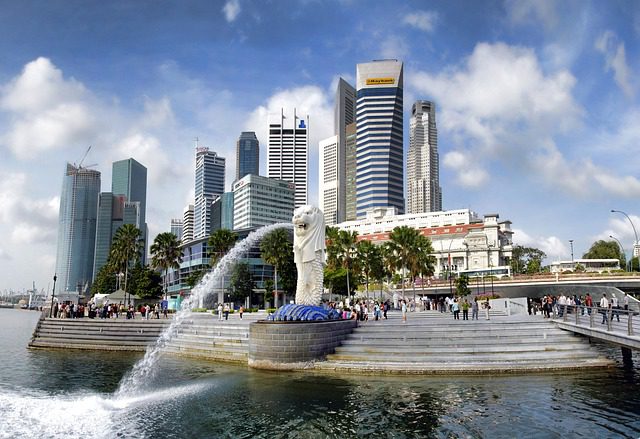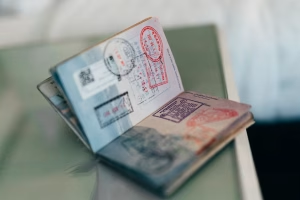Singapore in January pulses with electric energy and excitement. The air feels charged with celebration as the city gears up for Chinese New Year later in the month or early February.
Elaborate street light-ups cast a festive glow, and the weather—though wet and occasionally blustery—stays warm enough for exploring.
- Is January a Good Time to Visit Singapore?
- Singapore’s Weather in January
- Cultural Experiences
- Events & Festivals
- Top Things to Do in Singapore in January
- Famous Places to Eat in Singapore in January
- Where to Stay in Singapore?
- Average Cost of a Trip to Singapore
- Tips for Making the Most of Your Singapore Adventure
- Why Choose OneVasco?
- FAQs
Is January a Good Time to Visit Singapore?
Yes, January can be a great time to visit Singapore, especially if you don’t mind a little rain. Another upside is that you’ll encounter smaller crowds at popular attractions compared to peak periods like July and December. Hotel rates also tend to be lower, except for the days around Chinese New Year.
Singapore’s Weather in January
Here’s a quick look at Singapore’s January weather:
|
Factor |
Details |
|---|---|
|
Average temperature |
24-29°C (75-84°F) |
|
Average rainfall |
238mm |
|
Average rainy days |
13 days |
|
Average daily sunshine |
6 hours |
|
Humidity |
77-85% |
The Northeast Monsoon season, which runs from December to March, influences Singapore’s weather in January. Expect short, intense downpours, occasionally accompanied by thunder. Winds can get gusty too.
Pack an umbrella or raincoat, but also sunglasses and sunscreen. Rainfall is heaviest in the afternoons, so plan outdoor activities for mornings or evenings. Indoor attractions like museums and malls are perfect for rainy spells.
Cultural Experiences
Singapore in January offers a chance to dive into the city’s vibrant Chinese culture. If your visit coincides with Chinese New Year (which can fall in late January or early February), you’re in for a treat. The whole city gets decked out in red and gold decorations.
Even if you miss the main celebration, there’s still plenty to enjoy in the lead-up to the festivities.
-
Head to Chinatown to see the stunning street light-up, featuring elaborate lanterns and sculptures.
-
Explore the festive bazaars along Pagoda Street, Smith Street, Sago Street, and Temple Street.
-
Sample local delicacies like pineapple tarts and bak kwa (barbecued pork jerky).
Don’t miss the chance to visit the Buddha Tooth Relic Temple, where you can admire its stunning architecture and learn more at the museum.

Events & Festivals
In addition to Chinese New Year festivities, Singapore in January hosts several other events worth checking out:
-
Art Week (Typically held annually from January 17–26): This annual celebration of visual arts features exhibitions, walks, talks, and fairs across the city. Don’t miss the Light to Night Festival, which illuminates the Civic District with stunning projections and installations.
-
Pongal Festival (Typically celebrated annually between January 14 and January 17): The Indian harvest festival sees the Little India neighborhood come alive with colorful decorations, folk performances, and a festive bazaar. Head to Campbell Lane to watch rice boil over in clay pots—a key ritual.
-
Singapore Fringe Festival (Held in January): This edgy arts festival showcases experimental theater, music, dance, and visual arts from both local and international artists. Performances take place at various venues around the city.
Top Things to Do in Singapore in January
Singapore offers a vibrant mix of activities in January, catering to all interests from food lovers to nature enthusiasts. Here are some top picks tailored for this month:
-
Hawker Centers: January is ideal for indulging in local cuisine. Popular dishes include chili crab at Jumbo Seafood and Hainanese chicken rice at Tian Tian, both of which are must-tries while enjoying the outdoor atmosphere that hawker centers offer.
-
Sentosa Island: With fewer crowds in January, enjoy attractions like Universal Studios and the S.E.A. Aquarium without long waits. The pleasant weather is perfect for relaxing on Sentosa’s beaches or taking in views from the Tiger Sky Tower.
-
Museums: Spend a rainy day exploring Singapore’s rich history and culture. The National Museum of Singapore and the ArtScience Museum are great choices, especially since many exhibitions are less crowded during this month.
-
Nature Reserves: January is a great time for hiking. Explore trails in Bukit Timah Nature Reserve or the Southern Ridges, where you can enjoy lush greenery and panoramic views without the heat of other months. The occasional rain can enhance the rainforest experience.

Famous Places to Eat in Singapore in January
January is a special time for food lovers in Singapore, with seasonal specialties and festive treats available. Here are some must-try foods specific to this month:
-
Chinese New Year Goodies: As the Lunar New Year approaches, Chinatown is bustling with festive treats. Look for pineapple tarts from Poh Guan Cake House, bak kwa (barbecued pork) from Lim Chee Guan, and kueh lapis (steamed layer cake) from Bengawan Solo.
-
Chili Crab: This iconic dish is a must-try in January. Head to seafood restaurants along East Coast Parkway, like Long Beach Seafood and Jumbo Seafood. Be sure to call ahead to reserve your crab, as they often sell out quickly during this peak season.
-
Fish Head Curry: A favorite among locals, this dish is particularly popular in January when the fish is fresh and flavorful. Visit Banana Leaf Apolo in Little India for their renowned fish head curry served on banana leaves.
Where to Stay in Singapore?
Singapore offers a wide range of accommodations to suit every budget and taste. Here are some popular areas to stay:
-
Marina Bay: For luxury hotels with stunning views, like Marina Bay Sands and The Ritz-Carlton Millenia.
-
Orchard Road: For shopaholics who want to stay right on Singapore’s retail haven, with options like Grand Hyatt and YOTEL.
-
Chinatown: For a taste of old-world charm, boutique hotels like Scarlet Singapore and heritage shophouses turned hostels.
-
Little India: For budget-friendly guesthouses and a vibrant ethnic enclave atmosphere, like Wanderlust and The Great Madras.
-
Sentosa Island: For family-friendly resorts with on-site attractions, like Resorts World Sentosa and Shangri-La’s Rasa Sentosa.
Average Cost of a Trip to Singapore
Singapore has a reputation for being an expensive city, but you can travel on a range of budgets. Here’s a rough guide:
|
Budget |
Stay |
Food |
Transport |
Attractions |
Total per day |
|---|---|---|---|---|---|
|
Budget |
S$20-50 (INR 1,300-3,200) hostel dorm |
S$10-20 (INR 650-1,300) hawker meals |
S$10-20 (INR 650-1,300) public transport |
S$0-30 (INR 0-2,000) free/discounted entry |
S$40-120 (INR 2,600-7,700) |
|
Mid-range |
S$100-250 (INR 6,400-16,000) hotel room |
S$30-60 (INR 2,000-3,900) restaurant meals |
S$20-40 (INR 1,300-2,600) public transport & taxis |
S$30-80 (INR 2,000-5,100) paid entry |
S$180-430 (INR 11,500-27,500) |
|
Luxury |
S$300+ (INR 19,000+) 5-star hotel room |
S$80+ (INR 5,100+) fine dining |
S$40-80 (INR 2,600-5,100) taxis & private cars |
S$100+ (INR 6,400+) tours & experiences |
S$520+ (INR 33,500+) |
Note: S$1 = approximately INR 64
Tips for saving money:
-
Stay in hostels or budget hotels outside the city center
-
Eat at hawker centers instead of restaurants
-
Take public transport (MRT/bus) instead of taxis
-
Buy a Singapore Tourist Pass for unlimited public transport rides
-
Visit free attractions like Gardens by the Bay (outdoor gardens), Singapore Botanic Gardens, and Sentosa’s beaches
-
Check for online discounts and bundle deals on attraction tickets

Tips for Making the Most of Your Singapore Adventure
Local Etiquette
-
Remove your shoes when entering temples and homes
-
Ask for permission before taking photos of people, religious sites, or government buildings
-
Dress modestly when visiting places of worship (cover knees and shoulders)
-
Don’t eat or drink on public transport
-
Don’t litter, spit, or smoke in public areas (hefty fines apply)
-
Queue up and wait your turn at hawker stalls, boarding areas, taxi stands, etc.
Currency
The Singapore dollar (SGD) is the official currency. Notes come in denominations of $2, $5, $10, $50, $100, and $1000, and coins in 5, 10, 20, 50 cents, and $1.
ATMs are widely available and accept international bank cards. Credit cards are accepted at most hotels, restaurants, and shops, with Visa and Mastercard being the most common.
Money changers offer competitive exchange rates, especially in areas like Orchard Road, Raffles Place, and Changi Airport. Rates are best for major currencies like USD, EUR, and GBP.
Why Choose OneVasco?
OneVasco makes visa applications effortless. Our expert team manages the entire process, allowing you to focus on your journey.
Enjoy stress-free travel with fast visa approvals.
-
Expert and Personalized Support
-
Efficient and Hassle-Free Process
-
Real-Time Tracking and Updates
-
Transparent Communication
-
Trusted by Millions
FAQs
1. What are the best things to do in Singapore in January?
Some top things to do in Singapore in January include:
-
Visiting the futuristic Gardens by the Bay and catching the Garden Rhapsody light show
-
Eating your way through hawker centers like Maxwell Food Centre and Lau Pa Sat
-
Exploring the cultural enclaves of Chinatown and Little India, especially during the festive season
-
Spending a fun-filled day at Sentosa Island, with attractions like Universal Studios and Adventure Cove Waterpark
-
Museum-hopping on a rainy day, with stops at the National Museum, ArtScience Museum, and National Gallery
2. Is Singapore cold in January?
No, Singapore in January is not cold. The average temperature ranges from 24°C (75°F) to 29°C (84°F), with high humidity levels. However, indoor spaces like malls and trains can be chilly due to air-conditioning, so it’s a good idea to carry a light jacket or shawl.
3. What can I wear in Singapore in January?
Pack light, breathable clothing for Singapore’s weather in January. Think cotton t-shirts, shorts, sundresses, and sandals. A light rain jacket or umbrella is essential for sudden downpours.
If you plan to visit temples or mosques, bring modest clothing that covers your knees and shoulders. For evenings out, smart casual wear is the norm.
4. Is Singapore expensive to visit in January?
Singapore can be an expensive city, but there are ways to stretch your budget.
-
Accommodation is the biggest expense, with hotel rooms averaging S$200-300 per night.
-
Food is more affordable, especially if you stick to hawker centers where meals cost S$4-10.
-
Public transport is cheap and efficient, with most rides costing under S$2.
-
Many attractions offer discounted tickets for advance online bookings.
5. How safe is Singapore?
Singapore is one of the safest cities in the world, with very low crime rates. Violent crime is rare and streets are well-lit and secure even at night.
However, petty crimes like pickpocketing can occur in crowded areas, so keep an eye on your belongings. Traffic is orderly and drivers generally follow rules, making it safe for pedestrians.
6. What can I see in Singapore in January?
Singapore in January is a great time to explore the city’s iconic attractions and vibrant neighborhoods. Must-sees include:
-
The Supertrees at Gardens by the Bay
-
The Merlion statue
-
The colonial-era Raffles Hotel
-
The Marina Bay Sands Skypark
-
Cultural districts of Chinatown
-
Little India
-
Kampong Glam, espeically for the festivities leading up to Chinese New Year
7. Will it rain in Singapore in January?
Yes, expect rain in Singapore in January, as it’s in the midst of the Northeast Monsoon season. January is one of the wettest months, with an average rainfall of 238mm spread over 13 days. Rainfall is often heavy but brief, usually occurring in the afternoons. Mornings and evenings tend to be drier and sunnier.





















